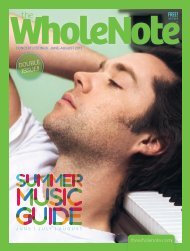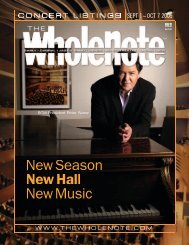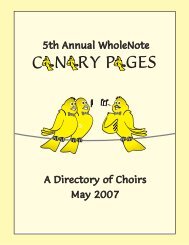PDF version - The Wholenote Magazine
PDF version - The Wholenote Magazine
PDF version - The Wholenote Magazine
You also want an ePaper? Increase the reach of your titles
YUMPU automatically turns print PDFs into web optimized ePapers that Google loves.
DISCOVERIES | RECORDINGS REVIEWED<strong>The</strong> extra month off since the publicationof our extended summer issuehas made it even harder than usual toreturn to the task at hand. Where to beginafter three months of eclectic listening? Oneongoing project over the summer involvedmore reading than listening, although itcertainly sent me back to my collection torevisit some of the great worksof the 20th century. Stravinsky –Discoveries and Memories is kindof a tell-all book by Stravinsky’samanuensis Robert Craft (NaxosBooks ISBN 978-1-84379-753-1). Craft worked intimately withStravinsky over most of the last25 years of the composer’s lifeand we are treated to a “fly on thewall” view not only of his creativebut also his social activities. <strong>The</strong>book is divided into three sections:<strong>The</strong> Music; <strong>The</strong> Man; Friendsand Acquaintances. It is thefirst of these that I foundmost interesting, primarilythe debunking of the mythof animosity between the“rivals” Stravinsky andSchoenberg. <strong>The</strong> second andthird sections with their focuson more prurient themes wasless satisfying although there are fascinatingmoments involving Stravinsky and some ofthe notable giants of the past century. Thisincludes not just the usual suspects — musiciansand artists Prokofiev, Diaghilev, Picasso,Dali, Gershwin, Copland, Carter, Sessions andBerio — but also literary and scientific figureslike T.S. Eliot, Thomas Mann, Aldous Huxley,Kenneth Clark and Edwin Hubble, plus a fewseemingly unlikely figures such as Mussoliniand Warren Zevon. It’s like a Who’s Who ofthe 20th century, but of course Stravinskyhimself would be at the top of that list. <strong>The</strong>book includes a CD with an outstandingperformance of <strong>The</strong> Rite of Spring with Craftconducting the Philharmonia Orchestra in2007 using the composer’s corrected 1967edition based on the 1913 original.One of the most recent discs to crossmy desk came from a local cellist I havelong admired, Coenraad Bloemendal, whoproduced it. Couleurs (Erdeco recordingstriodesiree.ca) is a collection of French artsongs by Duparc, Fauré, Debussy and Damasefeaturing Swiss-born Dutch soprano DésiréeTill and one of Canada’s national treasures,harpist Erica Goodman. <strong>The</strong> Fauré andDebussy transcriptions are by Goodmanwith Charles Heller handling the Duparc.Till’s credits stem mostly from the worldof operetta on the European stage but sheDaviD OLDSachieved her masters in Music Interpretationat the Université de Montréal in 2009 andthe following year founded Trio Désiréewith Goodman and Bloemendal. Althoughat times I find her voice a bit too “big” forthe intimacy of this repertoire, she workswell with Goodman in the bulk of the selections,consisting of harp transcriptionsof pianoaccompaniments. Mosteffective for me arethe tracks that includeBloemendal’s expressivecello lines which greatlyadd to the contrast ona disc which at othertimes suffers froma certain samenessof texture.Although onemight think thatany disc entirely devotedto one combinationof instruments (orvoices) might be susceptibleto the same criticism,certainly this is notthe case in Liquid Statesrecently released by theVancouver ensembleStanding Wave (Redshift MusicTK427 redshiftmusic.org). <strong>The</strong>group’s instrumentation is fairlyunusual — clarinet(s), violin, cello,piano and percussion — but even this somewhatlimited palette is used with greatdiversity by the four composers representedhere. Jeffrey Ryan’s Burn is perhaps the mosttraditional with its lyrical melodic lines andmoods that shift between sombre stasis andwhirling rising motifs. Jocelyn Morlock’s<strong>The</strong>ft I: Water Clocks and <strong>The</strong>ft II: Insomniaopens extremely quietly with soft arpeggiatedpiano, droning clarinet and a veryhigh violin melody. <strong>The</strong> textures thicken asthe movement develops and cello and vibraphoneare added to the mix before returningto near inaudibility. <strong>The</strong> second movementis a stark contrast beginning with an abruptdrum roll and a busy piano line over whichviolin and clarinet interpolate bird-like callsand twitters. It’s no wonder there’s no sleephere. Rodney Sharman’s Pavane, Galliard,Variations is another soundworld altogetherwith its reinvention of keyboard worksby English renaissance composer WilliamByrd. <strong>The</strong> strings and clarinet are played in amanner suggestive of a consort of viols, withthe piano notes damped and the percussionutilizing eerily pitched gongs. <strong>The</strong>severy effective pieces transport us back to animagined time half a millennium ago. In starkcontrast Linda Bouchard’s Liquid States withits strummed violin chords and plucked cellonotes combining with low piano ostinatos,high-hat paradiddles and whining clarinetlines carries relentlessly forward on a 15-minute voyage that culminates in metallophonecacophony before gradually subsiding.An exciting journey indeed.<strong>The</strong> final two CDs have a number of thingsin common: local composer-performerscreating unique hybrids of classical and jazz,with some pop and world music influences,fine musicianship and excellent productionvalues. It does not come as a surprise thatwith regard to this latter aspect thebulk of the recording was doneat Toronto’s Canterbury Musicfacility, known for a long historyof attention to detail and use ofthe most appropriate technologies(vintage analog to contemporarydigital) to achieve itssignature warm, clean sound.This has attracted innumerable artistsfrom across the spectrum includingBarenaked Ladies, Molly Johnson,Moe Kauffman, Auto Rickshaw,Colm Wilkinson, Kiran Ahluwaliaand the Gryphon Trio to name buta few.<strong>The</strong> eponymous Shannon Grahamand the Storytellers (shannongraham.ca)(which also featuressome tracks recorded at theequally renowned Farm Studio)features a local band that oftensounds bigger than its parts.Graham, on tenor sax, violaand occasional vocals, is joinedby a host of friends on violins,(another) viola, trumpet, trombone,electric guitar, keyboard,bass and drums. I listened to this eclecticdisc a number of times before consultingthe booklet and was a bit surprised to readabout the influences which range fromBuddhism, Kurt Vonnegut and BenjaminBritten to everyday occurrences like chasinga runaway dog and taking an overnight bustrip from NYC to Toronto. I’m not sure whatI would have expected such a mixed bag tosound like but this self-described classicaljazz-popband is full of surprises. <strong>The</strong> storiesare mostly told in an instrumental fashion,with occasional vocalise, and only rarelyinclude narrative. <strong>The</strong> textures range fromlush and luscious to sparse and spiky. <strong>The</strong>reare dissonant sections but overall the moodis playful and the sounds a blend of modernjazz and chamber music, occasionally reminiscentof themes from You’re a Good ManCharlie Brown. I mean that in the nicestpossible way.<strong>The</strong> Other Side of the Air by Canadianbanjo player and composer Jayme Stone(jaymestone.com) is, if possible, even moreeclectic that Shannon Graham’s disc. <strong>The</strong> coreensemble backing Stone on seven originalcompositions consists of familiar names fromthe local jazz scene: Joe Phillips (bass), Kevin60 | September 1 – October 7, 2013 thewholenote.com
















